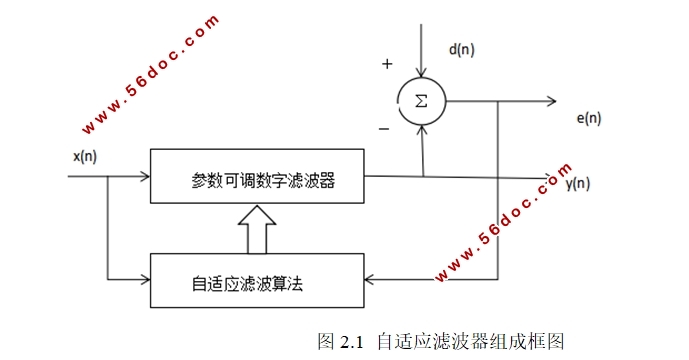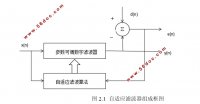自适应滤波算法的研究及MATLAB实现
来源:56doc.com 资料编号:5D27761 资料等级:★★★★★ %E8%B5%84%E6%96%99%E7%BC%96%E5%8F%B7%EF%BC%9A5D27761
资料以网页介绍的为准,下载后不会有水印.资料仅供学习参考之用. 密 保 惠 帮助
资料介绍
自适应滤波算法的研究及MATLAB实现(任务书,开题报告,论文17000字)
摘 要
自适应滤波算法性能的优劣直接影响着自适应信号处理的结果,故在自适应信号处理领域中,算法的研究是重中之重。本文对自适应滤波技术的基本原理进行概述,重点开展了对以维纳滤波理论为基准提出来的LMS算法的研究。
文章在论述传统LMS算法基本原理的基础上,对算法性能的衡量指标开展学习,并针对传统LMS算法存在的不足,结合参考文献的介绍,以提升传统LMS算法的性能为目标,学习和研究了归一化LMS算法、基于Sigmoid函数的SVS-LMS算法和基于Sinh函数的Sinh-LMS算法等变步长LMS算法。
最后借助MATLAB软件对本文研究的传统LMS算法及改进型算法进行仿真,论证本文介绍的三种改进型LMS算法均能在保证系统稳态误差的前提下,提升算法收敛速度,整体性能有了很大的提高。
关键词:自适应滤波;LMS算法;NLMS算法;Sigmoid函数;双曲正弦函数
Abstract
The performance of adaptive filtering algorithm directly affects the result of adaptive signal processing, so the research of algorithm is the most important in the field of adaptive signal processing.Thispaper summarizesthe basic principle of adaptive filtering technology,and focuses on the research of LMS algorithm based on Wiener filtering theory.
On the basis of discussing the basic principle of traditional LMS algorithm, this paper studies the performance measurement of the algorithm.And aiming at the shortcomings of the traditional LMS algorithm, combined with the reference, in order to enhance the performance of the traditional LMS algorithm as the goal.Then we study the variable step LMS algorithm such as NLMS algorithm, SVS-LMS algorithm based on Sigmoid function and Sinh-LMS algorithm based on hyperbolic sine function.
Finally,the traditional LMS algorithm and the improved algorithm are simulated by MATLAB software. The three improved LMS algorithms presented in this paper can improve the convergence speed of the algorithm under the premise of ensuring the steady-state error of the system, and the overall performance has been greatly improved.
Key Words: Adaptive filtering; LMS algorithm; NLMS algorithm; The Sigmoid function; Hyperbolic sine function

目 录
第1章 绪论 1
1.1 课题研究背景及意义 1
1.2 国内外研究现状 2
1.3 本文主要研究内容 3
第2章 自适应滤波器及其算法原理 4
2.1 自适应滤波器的基本原理 4
2.2 自适应滤波算法的理论研究 5
第3章 最小均方(LMS)算法的研究及实现 7
3.1 维纳滤波 7
3.2 最陡下降法 8
3.3 最小均方(LMS)算法 9
3.3.1 LMS算法描述 9
3.3.2 LMS算法的收敛性 11
3.3.3 LMS算法的收敛速度 11
3.3.4 LMS算法的期望学习曲线及性能 12
3.4 LMS算法的仿真实现 13
第4章 改进型LMS算法的研究及实现 17
4.1 归一化LMS算法 17
4.1.1 归一化LMS算法的基本原理 17
4.1.2 归一化LMS算法的仿真实现 18
4.2 基于Sigmoid函数的SVS-LMS算法 20
4.2.1 SVS-LMS算法的基本原理 20
4.2.2 SVS-LMS算法的仿真实现 21
4.3 基于双曲正弦函数的Sinh-LMS算法 24
4.3.1 Sinh-LMS算法的基本原理 24
4.3.2 Sinh-LMS算法的仿真实现 25
4.4 传统LMS算法与改进型LMS算法的比较及分析 27
第5章 总结与展望 30
5.1 本文工作总结 30
5.2 展望 30
参考文献 32
致 谢 33
|



